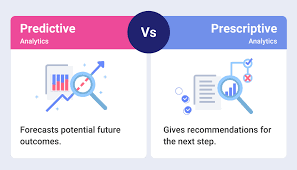All companies wants to make better decisions, improve operations, and foresee the future in the data-driven age, and in this pursuit, they need all the help they can get. Among the tools aiding these efforts, predictive and prescriptive analytics have played a central role, in particular in sales. Leaders of sales, marketing, and data teams need to understand the distinction between these two types of analytics in order to have a competitive advantage.
In this article, we’ll break down Predictive vs. Prescriptive Analytics, explore their practical applications, and explain why they are key to unlocking the full potential of AI, data analytics, and automation in the future of sales.

What is Predictive Analytics?
Definition
Predictive analytics involves using historical data, statistical algorithms, and machine learning techniques to forecast future outcomes. It answers the question: “What is likely to happen?”
Key Components
- Data Mining: Extracting patterns from large datasets.
- Machine Learning Models: Algorithms like decision trees, neural networks, and regression analysis.
- Statistical Techniques: Probability theory and predictive modeling.
Example in Sales
A company uses predictive analytics to forecast next quarter’s revenue based on past sales performance, seasonal trends, and market changes.
Benefits
- Improved demand forecasting
- Better customer segmentation
- Enhanced lead scoring
What is Prescriptive Analytics?
Definition
Prescriptive analytics goes a step further by not only forecasting outcomes but also recommending actions to achieve desired results. It answers: “What should we do about it?”
Key Components
- Optimization Models: Suggest the best course of action among multiple choices.
- Simulation: Evaluate the impact of decisions before implementation.
- Advanced AI Techniques: Reinforcement learning, real-time decision engines.
Example in Sales
After forecasting a dip in sales in a certain region, prescriptive analytics recommends reallocating the budget, launching targeted promotions, and adjusting inventory levels.
Benefits
- Smarter decision-making
- Cost reduction and revenue maximization
- Real-time, actionable insights
Predictive vs. Prescriptive Analytics: Key Differences
| Feature | Predictive Analytics | Prescriptive Analytics |
|---|---|---|
| Purpose | Forecast future events | Recommend actions to influence outcomes |
| Core Question | What is likely to happen? | What should we do? |
| Techniques | Statistical modeling, ML | Optimization, simulation, AI |
| Output | Probabilities and trends | Decision options and strategies |
| Role in Sales | Lead scoring, sales forecasts | Pricing optimization, strategy planning |
Why It Matters: Relevance to the Future of Sales
As the sales landscape evolves, so do the expectations of customers. Speed, personalization, and accuracy are now non-negotiables. Here’s how predictive and prescriptive analytics are transforming sales:
1. Hyper-Personalization
Predictive analytics helps tailor product recommendations, while prescriptive analytics determines the optimal outreach strategy for each segment.
2. Revenue Optimization
By combining both, businesses can forecast revenue and take action to mitigate shortfalls or capitalize on growth opportunities.
3. Automation of Sales Processes
With AI and automation tools integrated, prescriptive analytics can automate decision-making in real-time, such as dynamic pricing or inventory allocation.
4. Sales Team Enablement
Sales reps are empowered with data-driven insights that guide them not just on what to expect but what to do next, increasing productivity and effectiveness.
Real-World Applications
Retail
- Predictive: Forecasts product demand for upcoming seasons.
- Prescriptive: Suggests optimal stock levels and distribution strategies.
Healthcare
- Predictive: Identifies patients at risk of readmission.
- Prescriptive: Recommends intervention plans to reduce readmission rates.
Financial Services
- Predictive: Detects potential fraudulent transactions.
- Prescriptive: Automates response strategies to minimize risk.
Implementation Challenges
Data Quality and Integration
Both types of analytics require high-quality, integrated data from multiple sources. Poor data leads to inaccurate predictions and misguided recommendations.
Technical Complexity
Prescriptive analytics, in particular, requires sophisticated models and greater computational power, often needing specialized tools and expertise.
Change Management
Organizations must be ready to trust data-driven decisions and align teams accordingly, which can involve a cultural shift.
Best Practices for Integrating Predictive and Prescriptive Analytics
- Start with Business Objectives: Define clear goals before diving into the data.
- Invest in Data Infrastructure: Ensure your data is clean, relevant, and accessible.
- Collaborate Across Departments: Sales, marketing, and IT must work together.
- Leverage AI-Powered Tools: Use platforms that combine predictive and prescriptive capabilities.
- Monitor and Iterate: Continuously refine models and strategies based on outcomes.
Predictive and prescriptive are not bu competitors but rather coordinating forces. Predictive analytics is about telling you, based on custom reconciliations and predictive trends, what’s likely to happen next — and prescriptive analytics is about instructing you what to do about it. The two combined makes for a great multimandatory tool set for anyone in today’s sales game.
With businesses adopting AI, data analytics, and automation, these types of analytics will continue to be building blocks required to remain competitive and aligned with market needs. Sales leaders who adopt both will be better able to enable growth, efficiency, and innovation.
Frequently Asked Questions (FAQ)
What is the main difference between predictive and prescriptive analytics?
Predictive analytics forecasts future outcomes, while prescriptive analytics suggests actions to achieve desired results.
Can a business use both predictive and prescriptive analytics?
Yes. In fact, using both together provides a more comprehensive and actionable approach to decision-making.
Is prescriptive analytics more advanced than predictive analytics?
Prescriptive analytics builds on predictive insights and incorporates optimization and AI, making it more complex and action-oriented.
How are these analytics used in sales?
They are used for lead scoring, forecasting, pricing strategy, resource allocation, and customer engagement planning.
Do I need AI to implement prescriptive analytics?
While not mandatory, AI significantly enhances prescriptive analytics by enabling real-time decisions and handling complex scenarios.